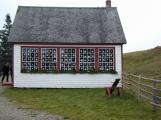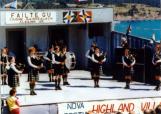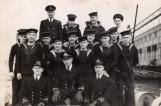14
Cape Breton in winterCirca 1991
Jamesville, Victoria County, Cape Breton, NS
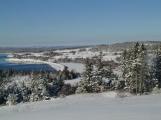 Credits:
Credits:Rodney Chaisson
15
Cape Breton was mainly Gaelic speaking until well into the end of the 19th century. The land the Barra people came to was forested and much different in climate. The first people who came wrote back to friends and relatives sending accounts of the life and what to bring with them when they came. One letter in the 1850s tells the reader to bring wagon wheels as there are not many to be had. They were for the most part totally Gaelic speaking. The tacksmen who came may have had some English as they had to communicate with the Scottish landlords about rents and farm produce. These English speaking settlers would have helped the others.16
Living history programs run at the Highland Village6 July 2007
Highland Village Museum, Victoria County, NS
 Credits:
Credits:Maria MacMillan
18
Schools were not established in Cape Breton in the first years of settlement. By 1830, there were several schools on the Island using Gaelic as the teaching language. As time went on, more schools were established with English eventually declared as the language of instruction. By the 1900s, English in the school had begun to erode the language in the home. Out migration to the New England states also encouraged use of English and young people who came home for visits often did not use their Gaelic as it was seen as backward. Repeated attempts in the Nova Scotia Legislature to entrench the language failed so Gaelic speaking children were taught without benefit of their own language and only in English.20
At the turn of the 20th century it is estimated that there were 50,000 gaelic speakers in Nova Scotia. Johnathan G. MacKinnon published a Gaelic newspaper, MacTalla, which gave a good look at the life of Gaelic Nova Scotia. MacTalla ran from 1892 until 1904. It was filled with stories, songs and folklore that would have otherwise been lost as well as news of the day and advertising, all in the Gaelic language. Societies of Gaelic speakers made efforts to maintain the language and customs of Gaelic Cape Breton. Movement of Gaelic speakers to urban areas also contributed to a decline as the language was not as likely to be passed on where English dominated in the population.22
In the 20th century, Gaelic societies continued their efforts to maintain the language. Classes were held in Sydney and in the outlying areas. In the 1930s then Premier Angus L. MacDonald, a Gaelic speaker, and the House of Assembly passed a resolution calling for a Gaelic program at the teacher's collage in Truro so that teachers could be trained in the language. A Gaelic college, independant of the school system, was established at St. Ann' s, Victoria County, and talks began to create a replica highland village somewhere in Nova Scotia complete with a Gaelic cultural resourse centre.23
Newspaper clipping of Gaelic College activities1950-1955
St. Ann's, Victoria County, NS
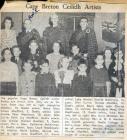 Credits:
Credits:Unknown
24
Stepdancing demonstration3 August 2007
Highland Village Museum, Victoria County, NS
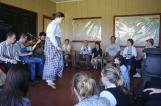 Credits:
Credits:Maria MacMillan
25
The outbreak of WWII effectivly put an end to the surge in interest in Gaelic. The language was banned in telecommunications, the introduction into the school system did not spread and little activity was seen for another decade. During the 1940s and 50s further attempts were made to educate adults in Gaelic but public school programs remained elusive and in 1964, after the government post of Gaelic advisor was discontinued, Gaelic was again dropped from the curriculum. The surge in multiculturalism in the 1960s renewed the interest in the language and by 1969 Gaelic was again given credit status in the public school system. Finding teachers was another matter. Teachers were brought in from Scotland and temporary funding put in place but the lack of specific funding within the school system and the temporary contracts made planning difficult. By 1980, only the county of Inverness was taking advantage of the program and, by 1982, only Mabou was providing the program. The language was again dropped from the curriculum in 1991.27
Comhairle na Gaidhlig - The Gaelic Council of Nova ScotiaNova Scotia, Canada
Comhairle na Gaidhlig:
Founded in 1986, Comhairle na Gàidhlig (The Gaelic Council of Nova Scotia) is a non-profit, volunteer society dedicated to the maintenace and promotion of Gaelic language and culture in Nova Scotia. We strive to represent the individuals, organizations and institutions of which this minority langauge group is composed. As a result, we organize a youth apprenticeship program each summer, are developing learning resources for community language courses, and support programs that promote Gaelic language and culture in Nova Scotia. Our audience extends to anyone with an interest in our work and the worldwide community of minority language supporters
Credits:Shamus MacDonald
